For some strange reason (though probably my love of multiple choice tests…) I followed a link from from Tricia’s blog, to see “if I could pass 8th grade science”… Here are the results.
I guess I can’t be too excited as, what there was of a stint in college for me (my grade school and high schooling was all pass/no-pass), I came out with a c-average anyway…
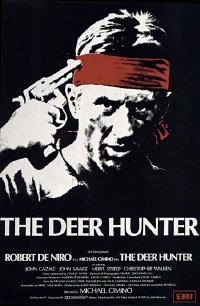 Well, as I learned from attempting to watch Heaven’s Gate a few weeks back, Michael Cimino’s films should probably have some heavy editing done in the first hour. Maybe trim a half hour. This time the film at stake was The Deer Hunter. Which, while the bonding/building scenes in the first third are too long (the film is three hours long), the story fares much better than in his later epic. This story of three steelworkers who are sent off to Vietnam, their experiences there and the repercussions upon their return, shows a harsh reality for those who fought in Vietnam both while over there and back home, all without taking a political or moral stance. It seems like a real movie for the veterans. But since I’ve never know one, I can only guess.
Well, as I learned from attempting to watch Heaven’s Gate a few weeks back, Michael Cimino’s films should probably have some heavy editing done in the first hour. Maybe trim a half hour. This time the film at stake was The Deer Hunter. Which, while the bonding/building scenes in the first third are too long (the film is three hours long), the story fares much better than in his later epic. This story of three steelworkers who are sent off to Vietnam, their experiences there and the repercussions upon their return, shows a harsh reality for those who fought in Vietnam both while over there and back home, all without taking a political or moral stance. It seems like a real movie for the veterans. But since I’ve never know one, I can only guess.
Regardless, it’s a strong movie. A great cast, including Robert De Niro, Christopher Walken, and Meryl Streep in one of her first roles, all do convincing jobs as a tight group of friends whose routines and relationships are permanently altered by the war. It also co-stars John Cazelle, who I always find intriguing. Not only because I find his characters to be quite terribly heart-wrenching (especially Fredo and Sal from Dog Day Afternoon) but because of the terrible arc of his brief film career; six years, five classic feature films (all of which were nominated for both the “best picture” Oscar and the “best drama” Golden Globe), and then death at 42, before The Deer Hunter was even released.
But back to the movie. Once they get to Vietnam, the movie picks up… A little too much for the characters involved. All of our stars end up together, in a spot they would rather not find themselves in. Through the tortuous realities brought by the Viet Cong, it is understandable how they got so many soldiers to sign those declarations and why so many Vet’s came back in the bad shape that they did. The pains that they have to put up with have effects that last far beyond the period when the physical pain eases, for some in this film, the tortures move from being the fear of the end, to becoming a way of life. Relationships and loyalites are strained and people are pushed beyond the limits where they recognize themselves. Not that I want to give much away, but not all three of these guys come home, whole in mind and body.
Though I’ve never actually read any of her books, I have long considered myself to be a fan of Ayn Rand. Not just on the basis of her reputation as a staunch advocate for the individual, but originally on the basis of watching the film of The Fountainhead as a youth.
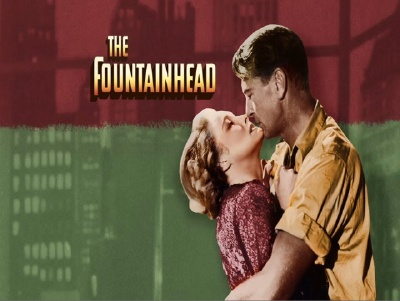
This compelling story of talent versus mediocrity, intellect versus establishment and confidence versus conformity always makes me feel all warm inside. Though, fittingly, the message is delivered rather heavy-handed. Gary Cooper plays Howard Roark, a talented and visionary architect who refuses to bow down to anything or anyone and would rather go penniless (or see one of his projects destroyed) before allowing anyone to spoil his creations. Though Cooper’s performance comes off a bit dry and preachy, as most of his dialog consists of philosophical speeches, the film features great turns by Ray Collins and Raymond Massey as wealthy men who are his only supporters in this foolish city of small-minded conformists.
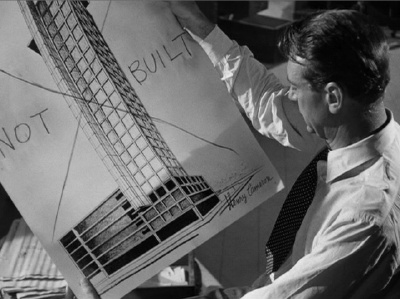
The drama really starts with the death of his mentor, Henry Cameron, who was beat down by his adherence to his vision and warns Howard not to follow the same path. As the story uses architecture as the basis for its “each against the mob-rule” philosophy, there is some great (and quite modern, for 1949) architecture on display here. Though it’s not really my style, the difference between it and the historically oriented designs that the film picks on is undeniable, and the stark styles that he puts forth certainly do have their appeal. The difference is so blatant that it hardly needs to be pointed out, but it is! And with a very blunt mockery… Early on, Roark presents clients with a design for their new ultra-modern skyscraper. They accept it, but then throw in a caveat… One small change, if you please.
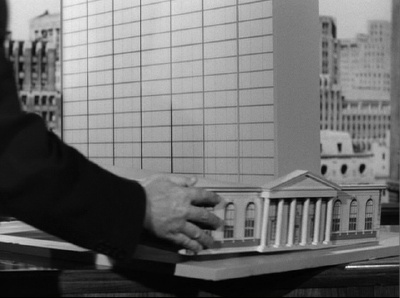
They bring in a federal style facade and base for the building and put them on the model, you know, to make it more acceptable to society. The ridiculous appearance that the building takes on perfectly represents the dull mediocrity that Rand challenges with the book (she also wrote the screenplay). They are stunned when he refuses to accept the modifications, even at the expense of losing the contract! Of course this set-back to his career conveniently opens the way to the awkward and cold romance with Patricia Neal ( an equally hard-nosed and misanthropic character) that becomes just as integral part of the Howard Roark story as his buildings.
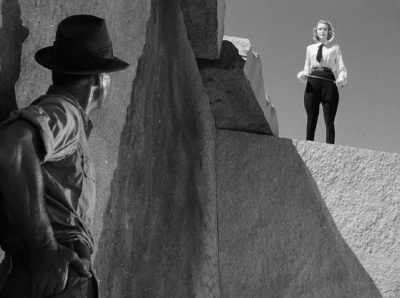
Of course, not all is lost, as not all men are slaves. Roark never falters in his work to create the structures that he dreams of. A great and inspirational movie, The Fountainhead tells a clearly laid out story of the need for determined struggle against conformity and the mediocrity, fascism and the danger to free-thinkers that not fighting this battle can lead to. The movie itself is also quite done, very nicely shot and with some nice sets and design. The only issue that I have is how stilted Cooper comes across, but I imagine that it is a combination of how serious the Roark character takes himself and the fact that Rand had to stuff the meat of this 700+ page novel into under 2 hours.










